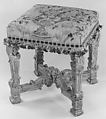Four-legged stool
Not on view
This four-legged stool exemplifies the skilled forms of carving found on a variety of seating furniture at the end of Louis XIV’s reign. This stool, or tabouret, consists of a padded rectangular seat resting on four legs. The top of each leg is carved with a reverse C-scroll embedded with a rosette containing a foliate ray. Each leg is joined by a wooden stretcher carved in the form of scrolls that meet the central block, which features a motif of egg and ribbon molding and is terminated by a seed-pod finial. Small yet often embellished with rich tapestries and ornate carving, tabourets formed an important part of ceremonies and etiquette at the French court under Louis XIV. Princesses and aristocratic ladies fought for the right to sit upon a stool in the presence of the king or queen. The exuberant scrollwork found on this small stool intimates the exuberant Rococo forms that emerged in Versailles following the death of Louis XIV in 1715, which would flourish under the rule of his great-grandson, Louis XV.
This image cannot be enlarged, viewed at full screen, or downloaded.
This artwork is meant to be viewed from right to left. Scroll left to view more.



